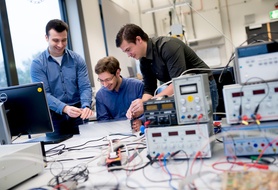A new radar sensor allows insights into the internal processes of snow avalanches. It was developed by engineers from Ruhr-Universität Bochum (RUB) led by Dr. Christoph Baer and Timo Jaeschke together with colleagues from Innsbruck and Davos. The measuring system has already been installed on a test slope in Valais, where the Swiss Institute for Snow and Avalanche Research plans to use it to carry out measurements in the winter of 2016/17. The data collected will be used in simulations that recreate the complex events inside avalanches in detail. "We don't know exactly what happens when an avalanche moves down a mountain, because so far we have only observed it from the outside," says Christoph Baer. Findings from the simulations could help create better devices to ward off avalanches.
Measure snow density
In principle, it is already known that avalanches consist of several layers that behave like solids, liquids or dusty gases. The new sensor detects variations in the density of snow in the dust layer. Among other things, the density affects the impact pressure of the avalanche, which is decisive for its destructive force. Only when the snow density is known the avalanche can be correctly simulated in terms of fluid mechanics.
The Bochum system uses radar to detect how many snow particles are in the dust layer. The more snow it contains, the slower the radar wave propagates. In this way, the researchers can draw conclusions about the snow density and record it in real time.
Aircraft aluminum sensor
The sensor is made of aircraft aluminum, as it has to withstand the enormous forces of the avalanche during the measurement. It is about one meter long, 30 centimeters thick and weighs 70 kilograms. An avalanche has an impact pressure of up to six bars. "That corresponds to a pressure of 3.5 tons - that is, two cars - on the surface of a DIN A4 sheet of paper," Baer illustrates. "It rolls right over our sensor. It's a challenge to get it to stick to the test mast and deliver usable measurement results."
The students Patrick Kwiatkowski and Henrik Deis built the sensor as part of their work as research assistants at the Chair of Integrated Systems of Prof. Dr. Nils Pohl. At the same chair, Timo Jaeschke is researching the millimeter-wave radar system used as part of his doctorate. Christoph Baer developed the underlying principle for radar-based density measurement in his doctoral thesis at the RUB Chair of Electronic Circuit Technology.
Waiting for the avalanche
The team from the Swiss Institute for Snow and Avalanche Research expects the first snowfalls in the cordoned-off Vallée de la Sionne test area before the end of 2016. If an avalanche does not go off on its own there, it will be triggered by a controlled blast at the end of the winter.


